Found the penultimate monarch in my "Anglo-Saxon Northumbria coins"
 Nap
Posts: 1,755 ✭✭✭✭✭
Nap
Posts: 1,755 ✭✭✭✭✭
With a recent pickup (a coin of Aelfwald I), I am now down to one missing monarch of the Anglo-Saxon kingdom of Northumbria. I was going to wait until I found the last one to post this topic, but I figure it may take a while (King Eardwulf, only 8 examples known), so I'll share the set in it's incompleteness.
This collection encompasses a period of about 150 years, from the early 8th century to the mid 9th. The Vikings conquered York in 867 and did issue some coins of their own, but they were broad pennies in the style of southern England, and fall outside of the scope of my collecting.
Northumbria developed a coinage of its own, beginning as silver sceats of about 12mm diameter, and then transitioning to brass stycas, of similar size. The early coins depict a creature, called a "fantastic animal", a four legged creature of some regal importance, which looks like a 'love child' of a dragon and a dog, or perhaps a deer. The reverse features the king's name. Later, the creature was dropped in favor of the moneyer's name on the reverse.
Designs are simple, and dispense of the early Anglo-Saxon symbolism found on early 8th century sceattas, in favor of a spartan but legible context. A few symbols do survive if you look for them, types of crosses, triquetas, and on a few issues the Greek letters alpha and omega. But other than that, there is a name on either side with not much else. The simplicity and legibleness, when compared to the prior coinage, is quite striking.
There are 12 monarchs and 5 church leaders who struck coins in their names, and examples of each are my goal to complete a full ruler set of the pre-Viking coinage of Northumbria.
Here are the coins:
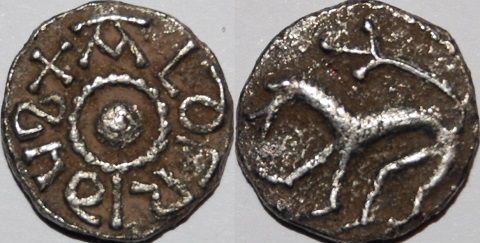
Aldfrith, king of Northumbria 685-705
O: +ALdFRIduS
R: Fantastic animal left
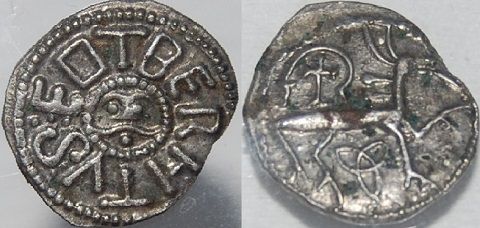
Eadberht, king of Northumbria 737-758
O: EOTBERHTVS:, mustached face in center
R: Fantastic animal facing right, triqueta below, cross under tail
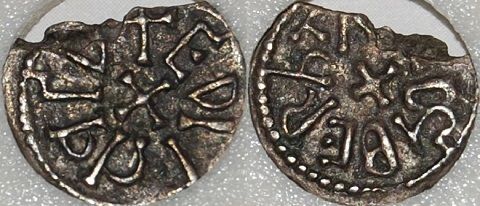
Aethelwald Moll, king of Northumbria 759-765 (with Ecgberht, Archbishop of York)
O: +EDILhpLd
R: ECGBERhT A[R]
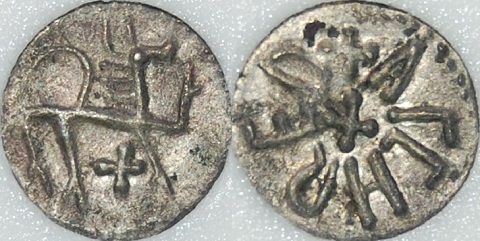
Alchred, king of Northumbria 765-774
O: +AGCHRED
R: Fantastic animal facing right, cross below
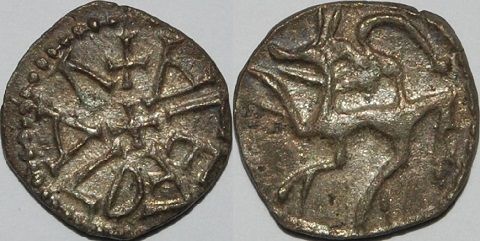
Aelfwald I, king of Northumbria 779-788
O: +AGEFDLAV (to be read 'AGEF VALD', partly retrograde)
R: Fantastic animal facing left
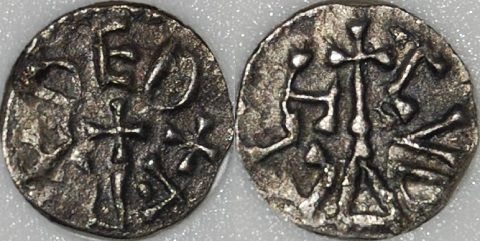
Aethelred I, king of Northumbria, second reign 789-796
O: +ED+G.RED
R: +CVD CLS
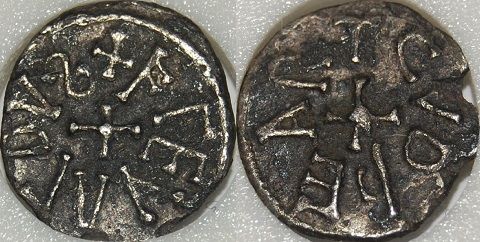
Aelfwald II, king of Northumbria 806-808
O: +FGEVAGDVS
R: CVDhEART
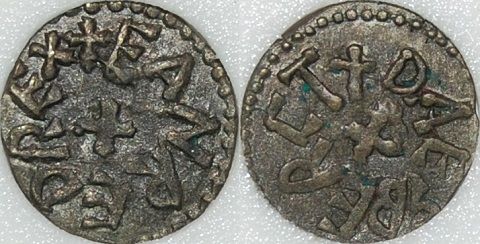
Eanred, king of Northumbria 810-841
O: +EANRED REX
R: +DAEGBERCT
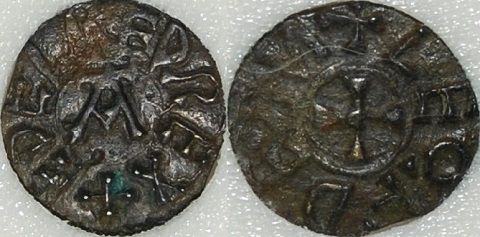
Aethelred II, king of Northumbria (first reign) 841-844
O: +EDELRED REX
R: +LEOFDEJN
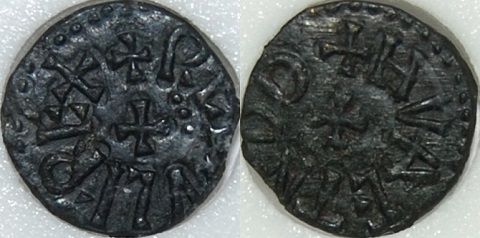
Redwulf, king of Northumbria 844
O:+REDVVLF REX
R: +HVAETNDD
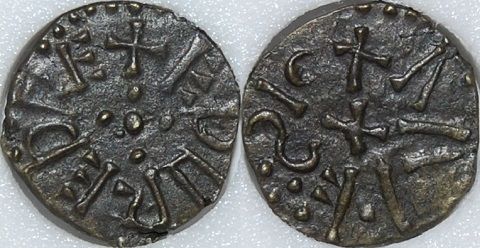
Aethelred II, king of Northumbria (second reign) 844-849
O: +EDLIRED RE
R: +VVI.FSIC
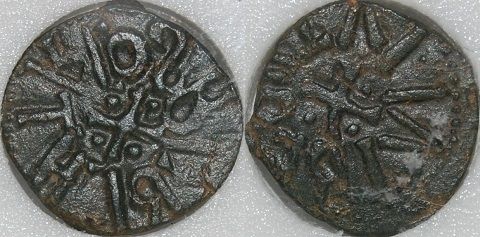
Osberht, king of Northumbria 849-867
O: OSBERCHT RE
R: VINIBERHT
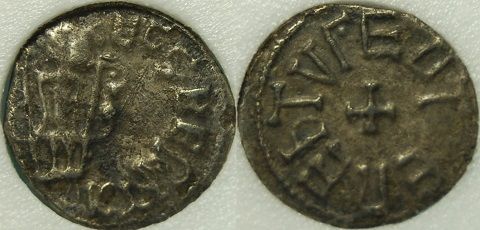
Ecgberht, archbishop of York (with Eadberht, king of Northumbria, 737-758)
O: EOTBEREhTV?.
R: ECGBERhT AR
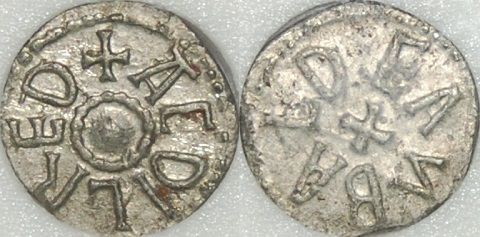
Eanbald I, archbishop of York 780-796 (with Aethelred I, king of Northumbria 774-780 and 789-796)
O: +AEDILRED
R: EANBALD
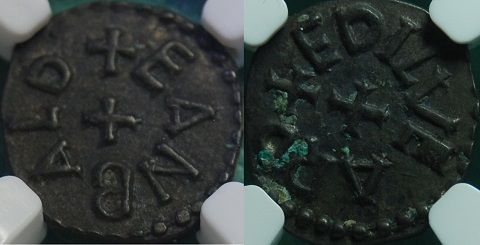
Eanbald II, archbishop of York 796-830
O: +EANBALD
R: +EDILVEARD
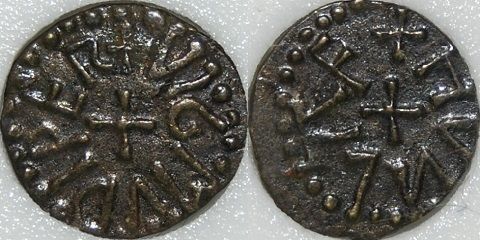
Wigmund, archbishop of York 837-854
O: +VIGMVD IPER
R: +HVNLAF
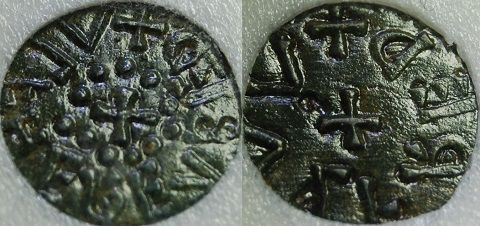
Wulfhere, archbishop of York 854-900
O: +VLFHERE ABED (retrograde)
R: +VVLFRED (retrograde)[/QUOTE]
This collection encompasses a period of about 150 years, from the early 8th century to the mid 9th. The Vikings conquered York in 867 and did issue some coins of their own, but they were broad pennies in the style of southern England, and fall outside of the scope of my collecting.
Northumbria developed a coinage of its own, beginning as silver sceats of about 12mm diameter, and then transitioning to brass stycas, of similar size. The early coins depict a creature, called a "fantastic animal", a four legged creature of some regal importance, which looks like a 'love child' of a dragon and a dog, or perhaps a deer. The reverse features the king's name. Later, the creature was dropped in favor of the moneyer's name on the reverse.
Designs are simple, and dispense of the early Anglo-Saxon symbolism found on early 8th century sceattas, in favor of a spartan but legible context. A few symbols do survive if you look for them, types of crosses, triquetas, and on a few issues the Greek letters alpha and omega. But other than that, there is a name on either side with not much else. The simplicity and legibleness, when compared to the prior coinage, is quite striking.
There are 12 monarchs and 5 church leaders who struck coins in their names, and examples of each are my goal to complete a full ruler set of the pre-Viking coinage of Northumbria.
Here are the coins:

Aldfrith, king of Northumbria 685-705
O: +ALdFRIduS
R: Fantastic animal left

Eadberht, king of Northumbria 737-758
O: EOTBERHTVS:, mustached face in center
R: Fantastic animal facing right, triqueta below, cross under tail

Aethelwald Moll, king of Northumbria 759-765 (with Ecgberht, Archbishop of York)
O: +EDILhpLd
R: ECGBERhT A[R]

Alchred, king of Northumbria 765-774
O: +AGCHRED
R: Fantastic animal facing right, cross below

Aelfwald I, king of Northumbria 779-788
O: +AGEFDLAV (to be read 'AGEF VALD', partly retrograde)
R: Fantastic animal facing left

Aethelred I, king of Northumbria, second reign 789-796
O: +ED+G.RED
R: +CVD CLS

Aelfwald II, king of Northumbria 806-808
O: +FGEVAGDVS
R: CVDhEART

Eanred, king of Northumbria 810-841
O: +EANRED REX
R: +DAEGBERCT

Aethelred II, king of Northumbria (first reign) 841-844
O: +EDELRED REX
R: +LEOFDEJN

Redwulf, king of Northumbria 844
O:+REDVVLF REX
R: +HVAETNDD

Aethelred II, king of Northumbria (second reign) 844-849
O: +EDLIRED RE
R: +VVI.FSIC

Osberht, king of Northumbria 849-867
O: OSBERCHT RE
R: VINIBERHT

Ecgberht, archbishop of York (with Eadberht, king of Northumbria, 737-758)
O: EOTBEREhTV?.
R: ECGBERhT AR

Eanbald I, archbishop of York 780-796 (with Aethelred I, king of Northumbria 774-780 and 789-796)
O: +AEDILRED
R: EANBALD

Eanbald II, archbishop of York 796-830
O: +EANBALD
R: +EDILVEARD

Wigmund, archbishop of York 837-854
O: +VIGMVD IPER
R: +HVNLAF

Wulfhere, archbishop of York 854-900
O: +VLFHERE ABED (retrograde)
R: +VVLFRED (retrograde)[/QUOTE]
0
Comments
How long ago did you begin assembling this set?
Amat Colligendo Focum
Top 10 • FOR SALE
How long ago did you begin assembling this set?
I think I'm now in my 5th year of collecting them.
That's an impressive accomplishment in so short of a time. I always like seeing a collection like this of material that I'm not familiar with and seems "undoable." A fascinating period and your coins epitomize it well. Congrats indeed!
World Collection
British Collection
German States Collection
WNC Coins, LLC
1987-C Hendersonville Road
Asheville, NC 28803
wnccoins.com
Anyway, that's a very impressive collection from the misty and mysterious British Isles of the Dark Ages. And all the more impressive to have been assembled in such a relatively short time.
A tremendously impressive set. I hope that you find the last coin you need.
My YouTube Channel
As an aside, have you heard that a 'sceat' is now a 'sceatt'? Look here: http://www.cngcoins.com/Coin.aspx?CoinID=318822
"The terminology for the denomination traditionally referred to as a ‘sceat’ has been fully analyzed in a recent article by John Hines (“The Hunting of the Sceatt” in T. Abramson, ed., Studies in Early Medieval Coinage, Volume III, Sifting the Evidence [Spink, 2014], pp. 7–17), that convincingly demonstrates that the correct term is sceatt, while the plural form remains Sceatta."
EVP
How does one get a hater to stop hating?
I can be reached at evillageprowler@gmail.com
Wow, what a set.I just started something similar. My first piece is a Aenred Sceat Phase II. I don't do much collecting in world coins, however I am a huge fan of history and being able to hold these little pieces of history while reading about it just makes it come more to life.
I think an Eanred coin started it for me as well. Eanred's coinage is among the more interesting, as it was during his time that the coins transitioned from good quality silver to debased brass. There were 20 moneyers that struck coins for him; I have examples of 19 of them.
There is also a (unique) broad penny in Eanred's name, also unique in the Northumbrian series (I might sell my car, and possibly my kidney if a second ever surfaced and was offered for sale)
Nice job, Nap. You have a few upgrades to keep a wary eye for, plus one actual hole. Time to venture afield, perhaps? I recall your saying to me about Mercia and Wessex? Since I am doing Wessex, I ask that you consider Mercia first (or, at least not compete with me on what I need). If you do decide to start on Mercia, I have a coin that I've been eyeing for myself that I'd tell you about. It's a killer of a coin, but pricey. Reach out to me privately if interested or just curious. (I have no stake in the coin, and in fact kind of hope the coin languishes until I win a big jackpot!)
As an aside, have you heard that a 'sceat' is now a 'sceatt'? Look here: http://www.cngcoins.com/Coin.aspx?CoinID=318822
"The terminology for the denomination traditionally referred to as a ‘sceat’ has been fully analyzed in a recent article by John Hines (“The Hunting of the Sceatt” in T. Abramson, ed., Studies in Early Medieval Coinage, Volume III, Sifting the Evidence [Spink, 2014], pp. 7–17), that convincingly demonstrates that the correct term is sceatt, while the plural form remains Sceatta."
EVP
EVP, as always your commentary is much appreciated.
I did not hear about the change in nomenclature. I have "Studies in Early Medieval Coinage" volume I and II, but not III. I think I'll pick up a copy. I always thought the terms "sceat," "sceatta," and "styca" were not contemporary terms and were applied to the early coinage by numismatists in the 18th century.
I don't think you have much to worry about me competing with you on Wessex. Besides some needed upgrades on the Northumbrian coins, I am probably going to chase the early sceattas next, which of course is an interest we also both share, but there are lots to go around. I have quite a bit of work to do before I can even come close to your collection.
Regarding the nomenclature, I think I've heard the same: not contemporary. But I think there's a more nuanced understanding. Imagine our society's terms for our coins: (official) cent, 5 cents, dime, quarter dollar, half dollar, dollar, and (colloquial) penny, nickel, quarter, money, etc.
I suspect that the Anglo-Saxon people had no official name for what we collect. Rather, it is more of an academic discussion over what is the correct spelling of a colloquial word. Please note that this is just a guess of mine. I really need to read more of these academic publications. Shame on me.
What is the correct plural spelling of "money"? "Monies"? Those ancient holed bronze coins of China are "chien", which means simply "money". Their plural is still "chien".
EVP
How does one get a hater to stop hating?
I can be reached at evillageprowler@gmail.com